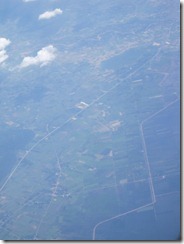The porters were setting up our tents when we arrived at Camp 30 Caves. They staked Betty’s and Kay’s tent that had flooded for the past two days on higher ground and dug small trenches around it to divert any water cascading down the mountain. Fortunately, the weather overnight cooperated and spared the ladies another night of traumatic moisture.
I spent the afternoon resting up for the next day’s challenging acclimatization climb half way to the top of Kilimanjaro. I’d been told that at this height we might experience headaches, lightheadness and loss of appetite. Fortunately, I’d been spared any side effects of altitude sickness thus far. Perhaps my prior experience in the highlands of Bolivia and Peru had helped me adjust to the height quickly. Then again, maybe not! I got sick when I was La Paz, Bolivia after flying in from the near-sea level city of Asuncion, Paraguay. Living at 1,280 meters (4,200 feet) in Lusaka, Zambia could have helped me better adjust to the higher altitude. Who knows. I was thankful not to be sick.
After a short nap interspersed with meditation and jamming out to some great music, I joined Kay and Tom for a quick jaunt in the afternoon. At first I wasn’t sure what I was getting into heading out in the light rain and put on my rain poncho as a precaution. Would it turn into a downpour on the trail? I wondered. Another climber at camp mentioned that we had missed the rain making the lower elevations miserable. Was it coincidence or just luck that we miraculously missed the rain? I don’t think so. Something greater than even the mighty Kilimanjaro had blessed us with ethereal weather.
At 4,000 meters I felt for the first time heavy air putting pressure on my lungs and hampering my breathing. I could feel the air’s reduced oxygen content and felt more winded doing moderately strenuous exercises than I normally would have been. The difference was noticeable but did not impede my climb or leave me in discomfort. It did, however, keep me mindful of the need to prepare for climbing at higher altitudes when I would be even more starved of oxygen.
During our hike the rain stopped and the clouds dissipated. The freakishly barren glacial gorge we had entered was absolutely stunning. Kibo Peak materialized before us to the right, and to the left the majestically jagged snow-capped peak, Mawenzi, soared above an imposing volcanic ridge. The gorge spilled down into the plain behind us as far as the eye could see. We could see the twinkle of lights from towns dotting the Serengeti dozens of kilometers away. It was a fantastic sight that could have provided the ideal backdrop for the Misty Mountains and Mines of Moria in J.R.R. Tolkien’s Middle Earth. It’s hard to believe that this Nordic-like tundra with edelweiss lay in the heart of Africa.
We hiked over an hour to a prominent vista point high above camp. Surveying the landscape, Kay and I scanned dozens of manmade rock piles dotting the horizon. Some were simple; others intricate and artistic. Our guide, August, informed us that they were markers to point out the trail, although I’m certain that some may have had a more meaningful purpose for other climbers intent on immortalizing a memory.
We returned to camp before dark and ate a meal much like ones we had eaten before ad nausea. Try as he might, our cook could only prepare a limited number of variations of soup and sauce with pasta to please our palettes. We ended our meal after sunset had robbed us of all vestiges of heat and frost had begun to blanket all exposed surfaces. For the first time on our journey, the cold came with a vengeance. Shivering for a while, I finally warmed up my tent with body heat and insulated gear. I wrapped myself in several layers of clothing and hugged my sleeping bag. Extra clothing insulated me from the frozen ground under the tent. I spent the rest of the evening alone listening to music on my iPod and writing this journal entry with a rudimentary notepad program I had downloaded to my Amazon Kindle. Thanks to technological innovations such as these, climbers can now enjoy entertaining diversions as they subject their bodies to extreme activities. It’s hard to imagine having as rewarding an experience without music and e-books by my side. I may very well be the first person to use a Kindle to write a journal on Kilimanjaro. It did an excellent job keeping me company.
Lesson learned: When packing for a climb, be sure to bring a warm blanket to cover your sleeping bag in the cold. A tent, mattress pad, and sleeping bag aren’t enough. A warm thermo blanket would have made a world of difference.




